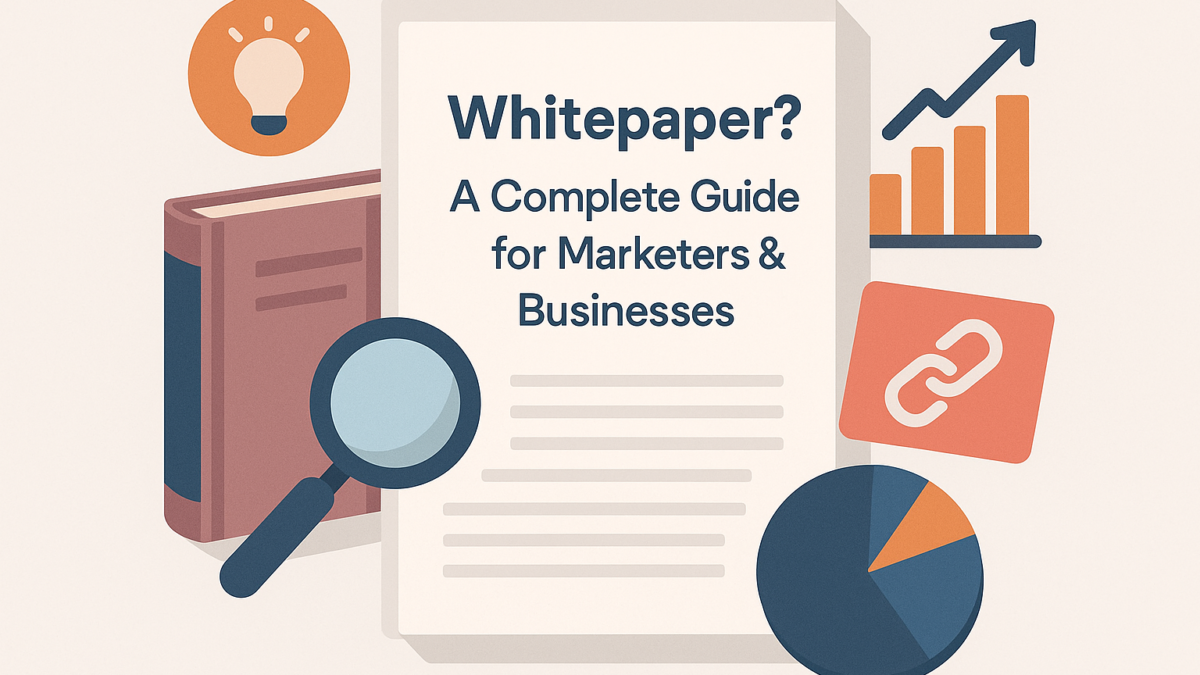What Is a Whitepaper? A Complete Guide for Marketers & Businesses
Table of Contents
In the world of B2B marketing, content is everywhere—but not all content carries the same weight. When businesses want to educate, influence, and convert high-value decision-makers, they turn to one format: the whitepaper.
Whitepapers are trusted, authoritative, and designed to turn complex topics into clear, actionable insights. They don’t just inform they persuade.
If you’ve ever wondered what a whitepaper really is, how it works, and how to create one that drives measurable results, this guide breaks it all down.
What Is a Whitepaper?
A whitepaper is a detailed, research-backed document designed to educate a target audience about a specific problem, industry challenge, trend, or solution. It goes deeper than a blog post or e-book, providing analysis, evidence, and practical recommendations.
Whitepapers are especially common in industries such as:
- Technology
- SaaS
- Finance
- Cybersecurity
- Healthcare
- Enterprise solutions
They’re often used in B2B lead generation, thought leadership, and sales enablement.
What Makes a Whitepaper Different From Other Content?
Whitepapers stand out because they are:
1. Authoritative
They position your brand as an expert by providing credible insights and clear reasoning.
2. Research-Based
Whitepapers rely on data, analysis, and real-world examples—not opinions or surface-level observations.
3. Problem-Solution Driven
They help readers understand a challenge and guide them toward a thoughtful, strategic approach.
4. High Intent & High Value
Because they provide depth and clarity, readers are typically decision-makers or professionals seeking actionable solutions.
5. Gated for Lead Generation
Most companies use whitepapers as downloadable assets in exchange for user details (email, company, role), making them powerful tools for capturing qualified leads.
Why Businesses Use Whitepapers
Whitepapers have become essential for B2B marketing because they offer several key benefits:
1. Build Thought Leadership
A strong whitepaper demonstrates expertise and helps your brand become a trusted authority in your industry.
2. Attract High-Quality Leads
Users willing to download and read a whitepaper typically have higher intent—making them valuable prospects.
3. Support Sales Teams
Whitepapers help clarify complex technologies, products, or industry challenges, giving sales teams a persuasive asset to share with potential buyers.
4. Educate Your Audience
They help prospects understand emerging trends, challenges, and best practices.
5. Strengthen Content Ecosystems
Whitepapers often become core assets that feed blog posts, social media, webinars, landing pages, and email campaigns.
Types of Whitepapers
Whitepapers come in several formats depending on your strategic goals:
1. Problem–Solution Whitepaper
Explains a major industry challenge and introduces a structured solution.
2. Backgrounder Whitepaper
Breaks down the technical aspects of a product or system in a clear, educational way.
3. Research & Insights Whitepaper
Presents data, trends, and analysis of an industry shift or market evolution.
4. Vision or Thought Leadership Whitepaper
Proposes a new approach, perspective, or future direction for your industry.
5. How-To or Framework Whitepaper
Provides guidance, methodologies, or frameworks readers can follow.
Whitepaper vs. Blog Post vs. E-Book: What’s the Difference?
Understanding the difference helps you choose the right format:
| Format | Length | Tone | Purpose | Audience |
|---|---|---|---|---|
| Whitepaper | 6–20+ pages | Formal, authoritative | Educate, persuade, build trust | B2B decision-makers |
| Blog Post | 800–1500 words | Conversational | Inform, attract traffic | Broad audience |
| E-Book | 10–30 pages | Light, visual | Guide, nurture, simplify | Mid-funnel readers |
Whitepapers deliver the deepest level of insight.
How to Create an Effective Whitepaper: Step-by-Step
Here’s a complete framework to build a high-impact whitepaper:
1. Choose a High-Value Topic
Pick a topic that solves a real problem your audience cares about.
Good topics often start with:
- “How to…”
- “Why businesses struggle with…”
- “The future of…”
- “The state of…”
Make sure it aligns with your product or service.
2. Define Your Target Audience
Identify who the whitepaper is for:
- CTOs?
- Marketing directors?
- Finance leaders?
- Enterprise IT teams?
This shapes the tone, depth, and content direction.
3. Conduct Research & Gather Data
A whitepaper must feel credible. Include:
- Industry insights
- Market observations
- Real examples
- Case studies
- Data analysis
- Frameworks
Your goal is to inform, not sell.
4. Create a Clear Structure
A typical whitepaper includes:
- Title Page
- Executive Summary
- Introduction
- Problem Statement
- Analysis or Insights
- Solution or Recommendations
- Case Study or Example
- Conclusion
- Call-to-Action
This structure ensures clarity and flow.
5. Write with Authority Not Promotion
The biggest mistake in whitepapers is making them too sales-oriented.
Instead:
- Be factual
- Be neutral
- Be clear
- Provide value before asking for anything
Position your brand subtly through insights—not pitches.
6. Design for Professional Readability
A good whitepaper should be well-designed:
- Clean layouts
- Readable fonts
- Diagrams or charts
- Brand-aligned colours
- Consistent formatting
- Download-ready PDF version
Visual appeal boosts engagement.
7. Publish, Promote & Gate the Whitepaper
To maximise results:
- Create a landing page
- Add a simple lead form
- Promote via LinkedIn, email, and newsletters
- Use it in sales outreach
- Include it in nurture sequences
A whitepaper can be one of your best long-term lead magnets.
Why Whitepaper Hosting Matters
Whitepaper hosting platforms allow marketers to:
- Upload and manage whitepapers
- Track downloads and views
- Organise assets for easy distribution
- Improve SEO visibility
- Automate lead capture and routing
Hosting ensures your whitepaper reaches the right audience while staying accessible and organised.
Conclusion
A whitepaper is more than just a document—it’s a strategic asset that educates, influences, and converts. Whether you’re positioning your company as an industry authority or generating qualified B2B leads, a well-crafted whitepaper can deliver outsized impact.
The key is simple: choose a strong topic, provide real value, support your insights with clarity, and present a clear next step.
You May Also Like: Why Every B2B Marketer Needs a Whitepaper Syndication Strategy (And How to Build One)





